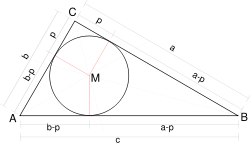In mathematics, the Gromov product is a concept in the theory of metric spaces named after the mathematician Mikhail Gromov. The Gromov product can also be used to define δ-hyperbolic metric spaces in the sense of Gromov.
Definition
Let (X, d) be a metric space and let x, y, z ∈ X. Then the Gromov product of y and z at x, denoted (y, z)x, is defined by
Motivation

Given three points x, y, z in the metric space X, by the triangle inequality there exist non-negative numbers a, b, c such that . Then the Gromov products are . In the case that the points x, y, z are the outer nodes of a tripod then these Gromov products are the lengths of the edges.
In the hyperbolic, spherical or euclidean plane, the Gromov product (A, B)C equals the distance p between C and the point where the incircle of the geodesic triangle ABC touches the edge CB or CA. Indeed from the diagram c = (a – p) + (b – p), so that p = (a + b – c)/2 = (A,B)C. Thus for any metric space, a geometric interpretation of (A, B)C is obtained by isometrically embedding (A, B, C) into the euclidean plane.
Properties
- The Gromov product is symmetric: (y, z)x = (z, y)x.
- The Gromov product degenerates at the endpoints: (y, z)y = (y, z)z = 0.
- For any points p, q, x, y and z,
Points at infinity
Consider hyperbolic space H. Fix a base point p and let and be two distinct points at infinity. Then the limit
exists and is finite, and therefore can be considered as a generalized Gromov product. It is actually given by the formula
where is the angle between the geodesic rays and .
δ-hyperbolic spaces and divergence of geodesics
The Gromov product can be used to define δ-hyperbolic spaces in the sense of Gromov.: (X, d) is said to be δ-hyperbolic if, for all p, x, y and z in X,
In this case. Gromov product measures how long geodesics remain close together. Namely, if x, y and z are three points of a δ-hyperbolic metric space then the initial segments of length (y, z)x of geodesics from x to y and x to z are no further than 2δ apart (in the sense of the Hausdorff distance between closed sets).
Notes
- Väisälä, Jussi (2005-09-15). "Gromov hyperbolic spaces". Expositiones Mathematicae. 23 (3): 187–231. doi:10.1016/j.exmath.2005.01.010. ISSN 0723-0869.
- Roe, John (2003). Lectures on coarse geometry. Providence: American Mathematical Society. p. 114. ISBN 0-8218-3332-4.
References
- Coornaert, M.; Delzant, T.; Papadopoulos, A. (1990), Géométrie et théorie des groupes. Les groupes hyperboliques de Gromov, Lecture Notes in Mathematics (in French), vol. 1441, Springer-Verlag, ISBN 3-540-52977-2
- Kapovich, Ilya; Benakli, Nadia (2002). "Boundaries of hyperbolic groups". Combinatorial and geometric group theory (New York, 2000/Hoboken, NJ, 2001). Contemp. Math. 296. Providence, RI: Amer. Math. Soc. pp. 39–93. MR 1921706.
- Väisälä, Jussi (2005). "Gromov hyperbolic spaces". Expositiones Mathematicae. 23 (3): 187–231. doi:10.1016/j.exmath.2005.01.010.

 . Then the Gromov products are
. Then the Gromov products are  . In the case that the points x, y, z are the outer nodes of a
. In the case that the points x, y, z are the outer nodes of a 



 and
and  be two distinct points at infinity. Then the limit
be two distinct points at infinity. Then the limit


 is the angle between the
is the angle between the  and
and  .
.
